
Welcome to Amanda's NICU Education




Hi! My name is Amanda. I'm a NICU nurse, Clinical Nurse Specialist, NICU Educator... basically your NICU BFF. If you want to talk NICU, I'm here for you! I love everything about NICU nursing and I'm eager to learn and share my knowledge with all my NICU friends.
I have been a NICU nurse since 2009 I am currently a Clinical Nurse Specialist in a Level IV NICU in Los Angeles.
I am passionate about educating the next generation of NICU nurses. I share my knowledge through platforms such as Instagram and Facebook and am excited to have you here on my website!
Click on the button below to sign up for my newsletter filled with NICU education and tips for all experience levels.

Not very many people love taking tests but as a self-acclaimed "forever student" who has taken (and passed) five different certification exams I am no longer afraid of tests! "Way to brag", you might be thinking but I want to help YOU pass your certification exam too!
Introducing Amanda's RNC-NIC Success digital course - your ultimate study companion!
Gain unlimited, on-demand access for life, ensuring you're primed to ace your certification exam.
I'm here to help you succeed and I can't wait for you to share with me that you PASSED the RNC-NIC EXAM!!!









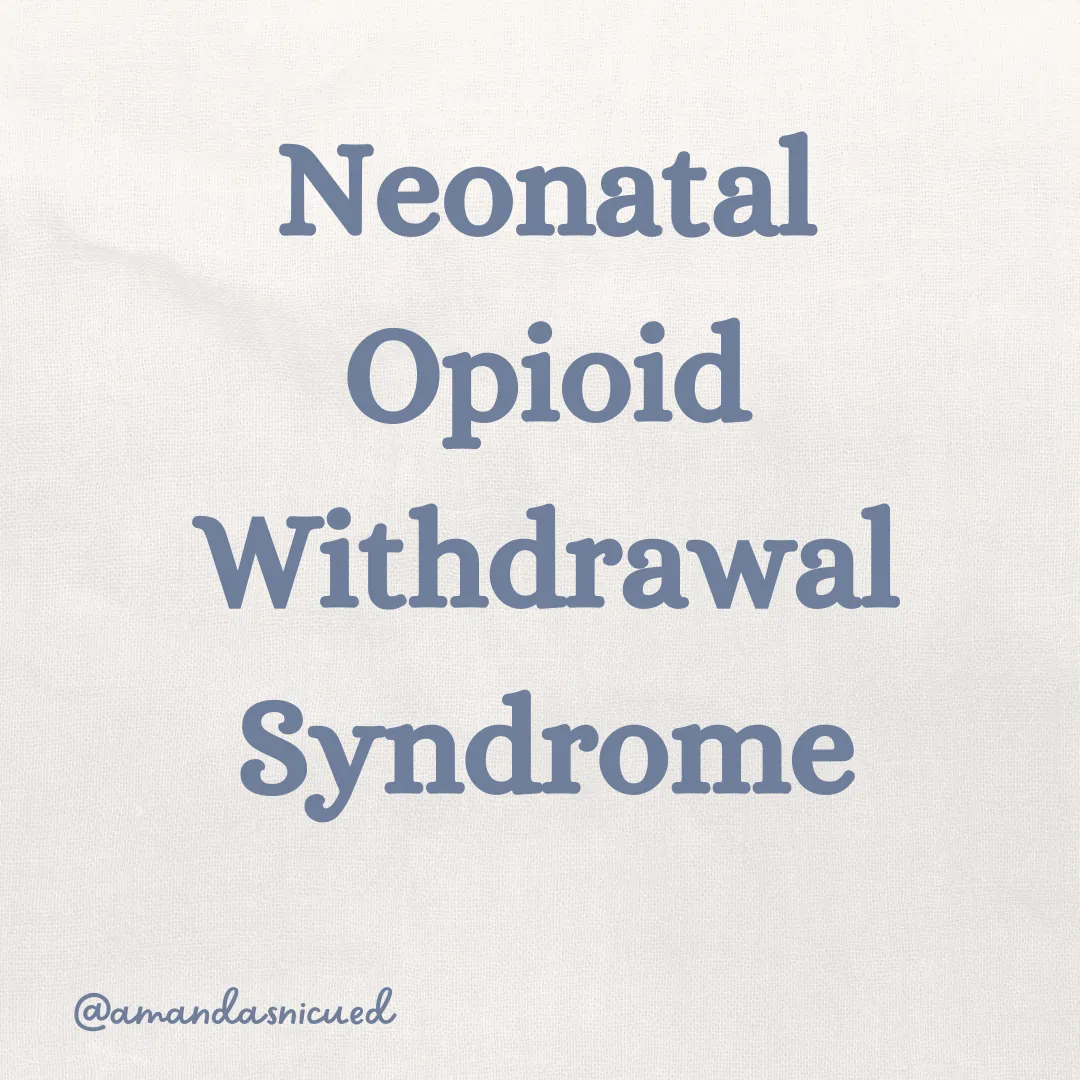
Neonatal Opioid Withdrawal Syndrome
Neonatal Opioid Withdrawal Syndrome
Neonatal Opioid Withdrawal Syndrome (NOWS) is a critical condition affecting infants exposed to opioids in utero. Opioid use has grown exponentially since the 90’s, therefore all healthcare workers caring for mother-infant dyads must be knowledgeable about its impact on pregnant women and their newborn babies. Let’s review the diagnosis, signs and symptoms, treatment approaches, family engagement strategies, and key nursing considerations when caring for infants affected by NOWS.
NOWS and NAS
Is NOWS a term you have heard before, or do you primarily hear about Neonatal Abstinence Syndrome (NAS)? It's important to differentiate between NOWS and NAS. While the terms are often used interchangeably, they have distinct meanings:
Neonatal Abstinence Syndrome (NAS) is a broader term that refers to withdrawal symptoms occurring in infants who were exposed to various substances, including opioids, benzodiazepines, and other drugs, during pregnancy. NAS encompasses the range of symptoms resulting from withdrawal from any substance.
Neonatal Opioid Withdrawal Syndrome (NOWS) specifically refers to withdrawal symptoms arising from exposure to opioids, including prescription medications (like oxycodone or methadone) and illicit drugs (such as heroin). NOWS is a subset of NAS that focuses exclusively on opioid exposure.
Diagnosis:
Diagnosing NOWS typically involves a combination of maternal history, clinical assessment, and standardized scoring tools. Key steps include:
Maternal History: Inquire about opioid use during pregnancy, including prescription medications and illicit drugs using a validated screening and assessment tool.
Clinical Assessment: Observe the infant for signs of withdrawal. Depending on the substance, withdrawal can occur up to 5 days after birth. For example, withdrawal from short acting opioids such as fentanyl can occur in as little as 3 days whereas long-acting opioids such as methadone may take up to 5-7 days.
Scoring Tools: Utilize standardized scoring systems, such as the Finnegan Neonatal Abstinence Scoring Tool and newer assessment tools like Eat, Sleep, Console, to objectively assess withdrawal severity.
Scoring Tools:
Two primary assessment tools are used to evaluate infants with NOWS:
Finnegan Neonatal Abstinence Scoring Tool: This tool is widely used and consists of a 21-item scoring system that assesses withdrawal symptoms in various categories, including central nervous system, gastrointestinal, and autonomic symptoms. Each symptom is scored, and the total score helps determine the severity of withdrawal and the need for intervention. Scores are typically assessed every 3-4 hours until the infant is stabilized.
Eat, Sleep, Console (ESC): This newer tool focuses on three key behaviors: feeding (Eat), sleeping (Sleep), and the ability to be consoled (Console). The ESC method emphasizes supportive care and the infant's ability to feed and settle. Instead of relying on a strict scoring system, it allows nurses to assess the infant's overall well-being. If an infant is able to eat well, sleep adequately, and be consoled with minimal intervention, they may not require pharmacologic treatment, which can reduce unnecessary medication exposure. A recent publication from the New England Journal of Medicine found the ESC method had a shorter length of hospital stay and less infants who required opioid treatment.
What does your NICU use? Finnegan Scoring or Eat, Sleep, Console?
Signs & Symptoms:
Infants with NOWS may exhibit a variety of signs and symptoms, which can vary in severity. Common indicators include:
Central Nervous System (CNS) Symptoms:
Irritability and excessive crying
Tremors and hypertonia
Seizures (in severe cases)
Gastrointestinal Symptoms:
Poor feeding and vomiting
Diarrhea
Dehydration
Autonomic Symptoms:
Sweating and yawning
Sneezing and nasal congestion
Fever
Treatment:
Non-Pharmacologic Treatment:
Supportive Care: Create a quiet, dimly lit environment to minimize overstimulation. Encourage parental rooming in and participation in care. Swaddling and gentle rocking can help soothe the infant.
Feeding Strategies: Frequent small feedings and monitoring for signs of dehydration are crucial for infants struggling with feeding.
Breastfeeding is a key nonpharmacologic intervention for Neonatal Opioid Withdrawal Syndrome (NOWS) and is generally safe for mothers using methadone or buprenorphine.
However, mothers with opioid use disorder (OUD) may face barriers to breastfeeding, such as long NICU stays and limited support resulting in low breastfeeding rates. Withdrawal symptoms in infants can make latching difficult, and some may need milk fortification due to weight loss, which further reduces breastfeeding attempts. Trauma-informed support is crucial, as many mothers with OUD have experienced trauma, including sexual trauma, which can impact their breastfeeding decisions.
Pharmacologic Treatment:
Opioids: When pharmacologic treatment is indicated, a trial of PRN morphine as an initial strategy for treatment (instead of scheduled Q3H dosing) can be beneficial. Morphine or methadone may be used as first line agents to manage withdrawal symptoms and titrated based on the severity of symptoms.
Adjunct Medications: Clonidine may be considered as a second line therapy. Clonidine is an alpha-2 adrenergic receptor agonist that inhibits CNS sympathetic outflow and reduces norepinephrine levels. In one RCT, clonidine showed reduced length of pharmacotherapy treatment for NAS.
Weaning of pharmacologic treatment should be done following a protocol.
Family Engagement:
Engaging families in the care of their infant with NOWS is essential for promoting bonding and improving outcomes. Strategies for effective family engagement include:
Education: Provide clear information about NOWS, its treatment, and expected outcomes. Use simple language and visual aids when possible
Involvement in Care: Encourage parents to participate in their infant’s care, such as feeding and comforting techniques, which can enhance attachment and promote emotional support
Support Resources: Connect families with counseling services and support groups to address their unique challenges, including the stigma often associated with opioid use.
Nursing Considerations:
As NICU nurses, our care is essential in managing opioid exposed newborns. It is important that we are well educated about the withdrawal tool used in our NICU. Whether it is the Finnegan or ESC, we must understand when and how to score signs of withdrawal. Caring for babies with NOWS requires multidisciplinary collaboration to provide a holistic approach to care. As nurses, we are an important advocate for families affected by opioid use disorder. Our unique role positions us to provide better care to babies and their families, reduce stigma associated with opioid use disorder, and encourage bonding and family participation in care.
Learn more about caring for families affected by opiod use

Neonatal Opioid Withdrawal Syndrome is a complex condition that requires a thorough understanding and collaborative approach to care. By recognizing the signs and symptoms, implementing evidence-based treatment strategies, and engaging families, NICU nurses can significantly impact the outcomes for infants affected by NOWS. Continued education and support are vital to ensuring that both infants and their families receive the best possible care during this challenging time.
Amanda xoxo
Missed my other newsletters? Click here to read them!
Let's Study Together! Join my Certification Course
References:
American Academy of Pediatrics. (2021). Neonatal Opioid Withdrawal Syndrome: A Clinical Report. Retrieved from AAP.org
D'Apolito, K., & D'Apolito, L. (2022). Opioid Use Disorder in Pregnancy and Neonatal Abstinence Syndrome: Management Strategies. Neonatal Network, 41(1), 23-30.
Finnegan, L. P., Connaughton, J. F., Kron, R. E., & McAuliffe, J. F. (1975). Neonatal Abstinence Syndrome: Assessment and Management. Pediatrics, 55(5), 639-646.
Jansson, L. M., Velez, M., & Harrow, C. (2017). The Eat, Sleep, Console Approach: A New Model for Assessing Infants with Neonatal Abstinence Syndrome. Hospital Pediatrics, 7(1), 49-56.
Kocherlakota, P. (2014). Neonatal Abstinence Syndrome. Pediatrics, 134(2), e547-e561.
Substance Abuse and Mental Health Services Administration. (2021). Medication-Assisted Treatment for Opioid Use Disorder. Retrieved from SAMHSA.gov
Mascarenhas, M., Wachman, E. M., Chandra, I., Xue, R., Sarathy, L., & Schiff, D. M. (2024). Advances in the Care of Infants With Prenatal Opioid Exposure and Neonatal Opioid Withdrawal Syndrome. Pediatrics, 153(2), e2023062871.
Young, L. W., Ounpraseuth, S. T., Merhar, S. L., Hu, Z., Simon, A. E., Bremer, A. A., Lee, J. Y., Das, A., Crawford, M. M., Greenberg, R. G., Smith, P. B., Poindexter, B. B., Higgins, R. D., Walsh, M. C., Rice, W., Paul, D. A., Maxwell, J. R., Telang, S., Fung, C. M., Wright, T., … ACT NOW Collaborative (2023). Eat, Sleep, Console Approach or Usual Care for Neonatal Opioid Withdrawal. The New England journal of medicine, 388(25), 2326–2337.
Agthe AG, Kim GR, Mathias KB, et al. Clonidine as an adjunct therapy to opioids for neonatal abstinence syndrome: a randomized, controlled trial. Pediatrics. 2009;123: e849-e856
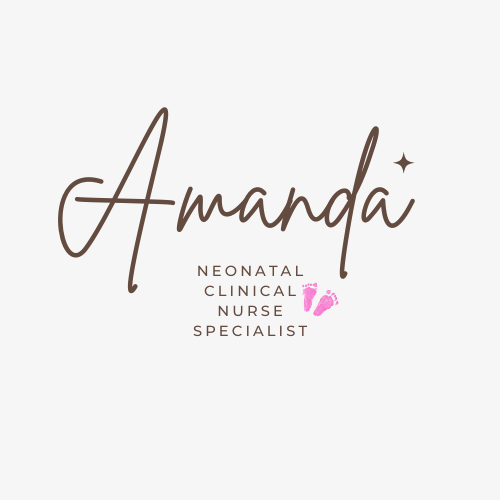
Copyright © {{right_now.year}} {{location.name}}, All rights reserved.

December 2023 Certification Review Webinar
NICU Certification Review


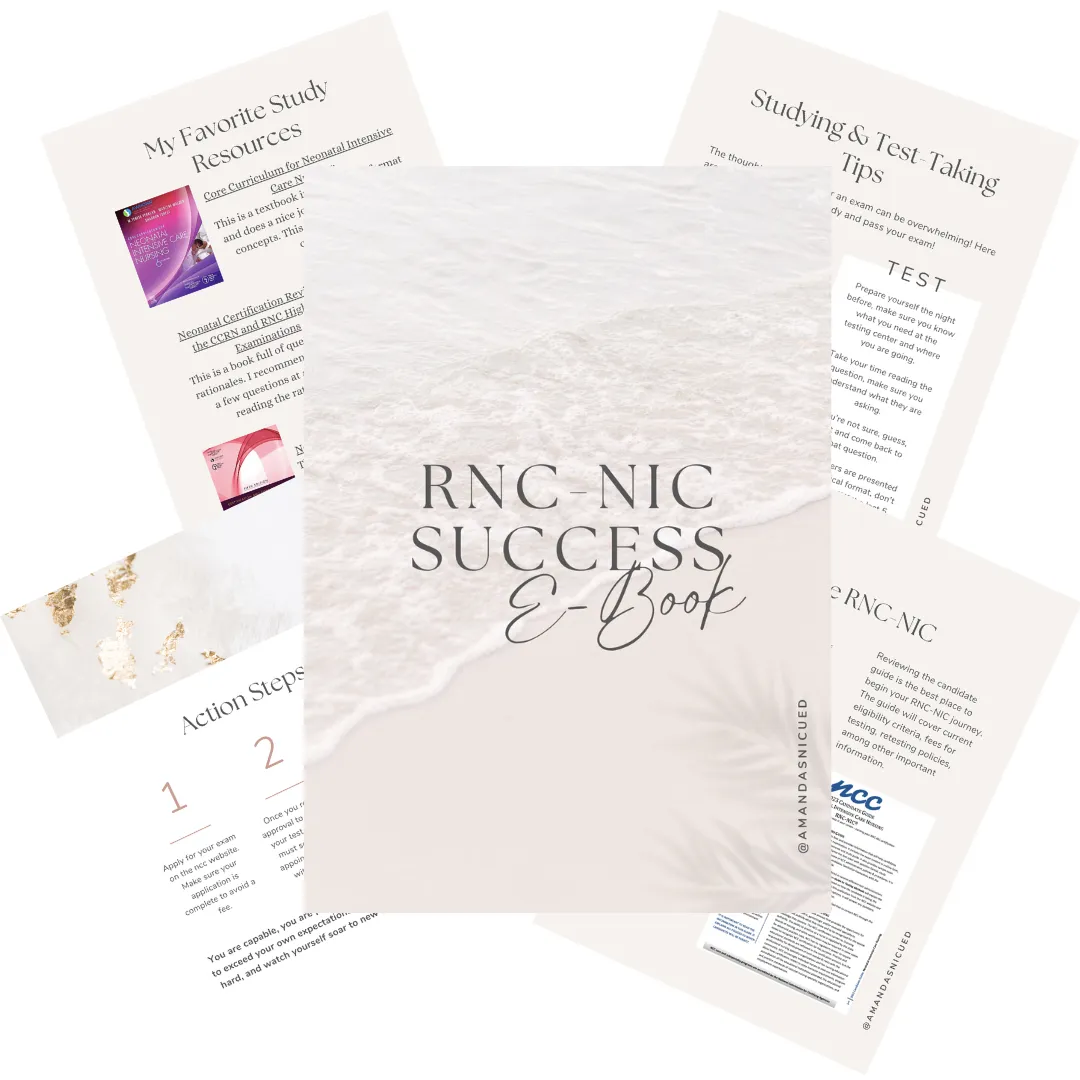
Ready to kickstart your journey to becoming a certified NICU nurse?
Look no further!
Grab my FREE E-Book packed with essential study and test-taking strategies for the RNC-NIC.
In the E-Book I give you the resources you need including the link to access the candidate guide, several types of books to study from, some of my favorite strategies, an outline of the content you should review, and a blank calendar for you to make your study plan!
Frequently Asked Questions About the RNC-NIC exam

What is the RNC-NIC?
The RNC-NIC is a competency-based exam that tests the specialty knowledge of nurses in the United States & Canada who care for critically ill newborns and their families.
The RNC-NICU is a nationally recognized certification that recognizes the registered nurse for their specialty knowledge and skill.
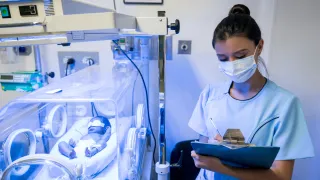
Who can take the RNC-NIC exam?
Nurses can take this exam after a minimum of two years experience in the NICU caring for critically ill newborns and their families.

Which books should I use?
I'm glad you asked! There are many excellent books to help you prepare for the RNC-NIC, I gathered ande describe each of them for you in my FREE e-book.
Is there a course to help me study?
Yes! Many hospitals host their own certification course and there are a few online courses. See my RNC-NIC test taking tips E Book for more information
What happens if I don't pass the exam?
If you don't pass the exam on your first try you can try again after 90 days. You will have to reapply after 90 days and pay a retest fee. There is no limit to the number of times you can take the exam (however a candidate can only sit for the exam twice per year).
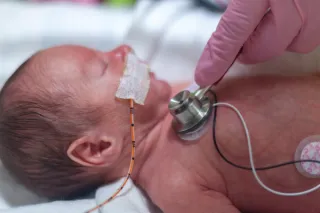
Can I make more money if I take the RNC-NIC exam and get certified?
Yes! Many hospitals provide a raise or a bonus for nurses with specialty certifications. Hospitals also typically hire at a higher base salary when nurses have a certification.

Find me @amandasnicued on these channels or Email me
hey nurses don't miss out
© Copyright 2024. AmandasNICUEd. All rights reserved. | Terms & Conditions | Privacy Policy Contact: [email protected]

